| 1 |
1960 -- The Jiucheng Bonsai Art Exhibition began today and ran until the end of the month. It
was held by the newly established Guangzhou Bonsai Art Research Association (later renamed the Guangzhou Bonsai
Association). That group invited relevant organisations from eight cities, including Shanghai, Guiyang, Nanning,
Xiamen, Kunming, Shantou, Foshan, and Xinhui, to jointly organise a grand bonsai exhibition in the large
Yuexiu Park in downtown
Guangzhou -- the city formerly known as Canton, in Guandong province. (This is about 66 miles/106 km
north-northwest of the coastal city of Macau in southeastern China.) This event was the first cross-regional,
large-scale bonsai art exhibition held after the founding of the People's Republic of China in 1949. The works
of hundreds of bonsai masters were exhibited. The invitation card for the Jiucheng Bonsai Art Exhibition was
designed and written by the famous calligrapher and master of Lingnan bonsai,
Mo Minfu (1903-1985), who also exhibited bamboo and grass
compositions there. (In the 1930s, Lingnan bonsai had experienced the improvement of what these compositions could artistically suggest. This was done by the members of the Guangdong Traditional Chinese Painting Research Association headed by Tie Chan (1865-1946), the abbot of Liurong Temple (Temple of the Six Banyan Trees) in Guangzhou. After the technical transformation work by Kong Taichu (1903-1985), Su Ren, Mo Minfu, Zhou Xingfu, Huang Jin, Su Qiao, and others in the 1950s, it gradually formed contemporary Lingnan bonsai.) [Guangzhou Penjing (Kuang-chou p'en ching) was the first bonsai picture album published after 1949. The dwarf potted trees in the book were photographed the year of Jiucheng and it was published by Beijing Xinhua Printing Factory in January 1962. The book contains a total of 85 representative works, involving 25 varieties of plants created by 25 Lingnan bonsai masters which have been regarded as classics by the Lingnan bonsai lovers of the past. Works by the six aforementioned masters are seen along with pieces designed by Chen Linpu, Chen Dechang, Li Kang, Zhou Keng, Li Chuan, Li Boqian, Guo Zhunan, Li Qikang, Chen Yan, Zhu Xuefeng, Chen Sheng, He Gongxia, Cai Junsan, Zhu Liqin, Yuan Caisheng, Huang Bosheng, and Zhang Ruitu, plus an example each from the Guangdong Science and Technology Museum and Shaujiwo Farm. The book Guangzhou Penjing faithfully reflects the artistic achievements of Lingnan bonsai at that time. Some sixty-six of the compositions shown are 15 pieces of Fujian tea (Ehretia microphylla, divided into small leaves and large leaves); 14 pieces of gulixiang (Murraya paniculata); 8 pieces of bird plum (Sageretia theezans); 7 pieces of Acacia spp.; 7 pieces of elm (Ulmus spp.); and 5 pieces each of mountain pine (Pinus hwangshanensis), water pine (Glyptostrobus pensilis), and pomegranate (Punica granatum). Another seventeen or so types make up the balance. Sixty years ago, the popular Fujian tea, gulixiang, sparrow plum, acacia, and elm had become outstanding native species for Lingnan bonsai, the Five Famous Lingnan trees passed down from generation to generation. (The single-represented dragon cypress, fragrant pine, white rice, and thorns from that time are almost never seen in the Lingnan bonsai exhibitions of today.) [In the year when the album was published, the master of the generation, the founder of the unique style of "Surenge," and the abbot of the Hai Tong Monastery in Guangzhou, passed away. The penjing of Chen Su Ren (aka Su Jen, 1894-1962) were noted for their aloof character and Chan-like star simplicity. The style atributed to him bears his name to this day, emphasizing heavily on negative space and minimum branches and leaves. His tree specimens, though similar in some ways to other literati penjing, have much leaner trunks and sparse foliage, true to his adage, "Perfection can be diminished by one twig too many or too few." His was an extreme approach to literati penjing. He invigorated the old Xu Hue Xe style (which was then called Wenren Mu), characterized by a willowy or sparse, thin trunk with bunches of foliage at the top and ends of branches in a small bowl. [A second school of Lingnan was that developed by Kong Taichu. (Please see his listing at Jan 30.) [A third school of Lingnan was the group headed by the Daoist priests of the Sanyuan Palace also in Guangzhou, which mainly used the dead tree stumps as materials, and after careful cultivation, new shoots grew from a certain part. [A few years later, the catastrophic Great Proletarian Cultural Revolution (May 1966-April 1969+) which swept across the country regarded the art of bonsai as "feudal black goods" and ruthlessly destroyed many Lingnan penjing treasures.] (From Allan Harding 09/10/20 posting of English translation of https://mp.weixin.qq.com/s/TiJQkf1yMoRH970NqYNRYA to FB group Penjing Australia Group, and reply on Sep 12 and 19 to RJB's questions as to when exhibition took place and what was gulixiang plant, RJB retranslated some sections of this article to get a smoother flow; Jonathan Henshaw's 2019 doctoral thesis, Serving the Occupation State: Chinese Elites, Collaboration, and the Problem of History in Post-war China, pg. 139 and footnote 278; Su Ren references: (Zhao, Qingquan Literati Style Penjing, Chinese Bonsai Masterworks, Shanghai Press, 2015, pg. 46; Petty, Cheryl "Chinese Penjing Styles and Culture," Golden Statements, Vol. XXXIV No. 5 Sep/Oct 2011; "Mini Chinese Elm Bonsai Grown from Root Cuttings," 01/10/2016; "The Art of Lingnan Penjing Bonsai"; "[Zhao] recalls that his first encounter with the literati style forty or more years ago was in a book illustration of the monk SuRen. He was intrigued by the ultra-simplicity of that rendering, which suggested an underlying richness," Bonsai Magazine, BCI, October/November/December 2015, pg. 49; Sanyuan Palace school from http://bonsaicn.net/index.php?regno=12&adiar=20131026 which RJB has only partly explored so far) SEE ALSO: Jan 30, May 11 |
| 2 |
1908 -- Paul Bourne was born in Seattle, Washington. [He would
be exposed during his youth to the art of bonsai through a Japanese neighbor
and on his subsequent trips to China and Japan in the 1930s. In 1948
he would take up residence at the Monastery of the Holy Spirit in Conyers,
Georgia. Fifteen years later he would begin puttering around making
bonsai. Thus would begin a pioneering journey that strongly influenced
the growth of bonsai throughout the southeastern U.S. and elsewhere.]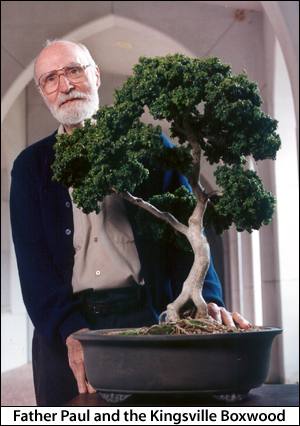
("Eulogy To A Bonsai Friend" by Jorge Lucero, Bonsai Magazine, BCI, September/October 1995, Vol. XXXIV, No. 5, pg. 51; Bonsai by the Monastery website: http://www.bonsaimonk.com/frpaul.html ) SEE ALSO: Jul 10 1996 -- The National Bonsai Foundation dedicated The Mary E. Mrose International Pavilion and the Dr. Yee-Sun Wu Chinese Garden Pavilion, marking the completion of the major pavilions of The National Bonsai and Penjing Museum at the U.S. National Arboretum in Washington, D.C. The 4,900 square foot Chinese Pavilion and Garden has a removable roof which will permit year-round exhibits and eliminate the need to move plants indoors during winter months. The traditional tiled formal entrance gate was fashioned in China and installed by seven artisans from Shanghai. The 4,391 square foot International Pavilion includes a traditional Japanese tokonoma, a Chinese Scholar's Studio, and a special place of honor as might be found in a typical American home. Additional features include a research center and information gallery, glass display cases for the National Collection of Viewing Stones, and a Special Exhibits Wing with an atrium for the formal display of bonsai and other related artefacts. The two new pavilions increase by 50 percent the formal bonsai and display area at the Arboretum. ("From the President..." by Martin Klein, Bonsai Journal, ABS, Summer 1996, pg. 47; "National Bonsai and Penjing Museum Now Complete," Bonsai Magazine, BCI, July/August 1996, pp. 18-23) SEE ALSO: Mar 21, Mar 27, May 17, Jun 9, Aug 26, Sep 30, Oct 1, Oct 15
2003 -- Marion Gyllenswan of Nanuet, New York died. (As a friend and student of
Yuji Yoshimura for over fifteen years,
her talents as a bonsai instructor were in great demand. She had been
an organizer, officer and director of both the Bonsai Society of Greater
New York and the American Bonsai Society. She was the latter's treasurer
from its founding in 1967 for two years, then the Business/Advertising
Manager of its Bonsai Journal through 1971. She was very active in
promoting the National Bonsai and Penjing Museum at the National Arboretum
in Washington, D.C. She was the Chairman and first president of the
National Bonsai Foundation, a very hard worker for this institution.
And Volume 3, Tape #6 of the
Masters Bonsai Techniques
videotape series featured Marion demonstrating three styles of Rock Planting Bonsai.) 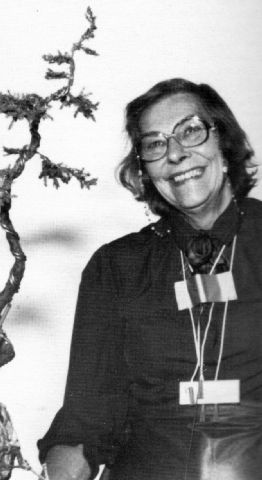
Marion Gyllenswan
(Internet Bonsai Club-posted e-mail from William N. Valavanis, May 2, 2003;
Bonsai Journal, ABS, Vol. 3, No. 2, pg. 2; "Minutes of First
Meeting of Board of Directors of the National Bonsai Foundation, Incorporated,
November 27, 1982," photocopy given by Felix Laughlin to RJB May 2002;
http://torontobonsai.org/Journal/Journal.2001/jun.2001/review.video5_6.htm;
"MARION R GYLLENSWAN" in Persons born on 5 May 1921 gives the erroneous
date of her death as 3 May) SEE ALSO: May 5, Sep 24
2014 -- The National Bonsai Hall of Fame was established at the National Bonsai Foundation's
annual meeting. (It had been thoroughly discussed with various concerns and parameters addressed
at the NBF's Executive Committee meeting the previous January 7.) The proposal was presented to
the full board at the National Bonsai & Penjing Museum in Washington, DC at the beginning of May and it
was approved.
John Y. Naka was selected to be the first inductee. Subsequent inductees
would be Yuji Yoshimura (2015) and William N. Valavanis (2017).(Bonsai Magazine, BCI, May/June 1986, pg. 14) "A National Bonsai Hall of Fame is an enduring way of honoring and recognizing individuals within the bonsai community of the United States for their valuable contributions to this art. The National Bonsai Hall of Fame will help the National Bonsai & Penjing Museum recognize people who have dedicated their lives to bonsai. The Museum, through the Hall of Fame, will identify and celebrate those in the United States who have achieved national excellence in the practice of the art of bonsai and have contributed to the advancement of bonsai within this country. And, by...attention to these renowned... who help to foster a greater appreciation for bonsai in this nation." Induction criteria: If living, must have been a resident of the United States for the last 10 years prior to induction. If deceased, must have been a resident of the United States for the last 10 years of their life. Induction is open to professional and non-professional bonsai artists and those who have made significant contributions to the art of bonsai in the United States. The Hall of Fame Committee will consist of nine (9) members: The Director, Gardens Unit Leader, Supervisory Horticulturist, Museum Curator, and Museum Assistant Curator will serve on the committee and two representatives from the National Bonsai Foundation and two representatives from the Consortium of Bonsai Curators will comprise the balance of the committee. (Alan Walker on FB Messenger to RJB, 10 Oct, 2017; WNV personal email to RJB 06/25/15 which contained HoF Guidelines; Schoech, Wayne "Bill Valavanis Inducted into the Bonsai Hall of Fame," BonsaiBark, 10/12/17) SEE ALSO: Sep 3 |
| 3 |
1935 -- Boh Chit Hee was born in Hainan,
an island off the southern coast of China. [His family would move to
Singapore when he was 4
years old (because of the Japanese occupation of
Hainan?). He would grow up in a very poor family and would have to sell fruits on the streets and wash
military tanks as a child in the
early 1940s. This would prompt
him to find solace in bonsai cultivation in 1953. His first tree was a plant that grew out of a wall. He would pluck it
out and grow and nurture it. (He would still have it decades later.) As bonsai were yet almost unheard of in
Singapore when he started, he would only learn from a couple of books he'd manage to get at that time. The rest would
be about trial and error, patience and very religious observation of daily growth, some of the very basic requirements of the
Lingnan style/technique from southeast China. He would start off with only a pair of gardening scissors, a pot, and
some earth. Almost all of his bonsai would emphasize the trunk and root structure, very similar to the Lingnan style.
Some 80% of his bonsai would be the Wrightia religiosa (shui mei)
species -- as was his very first tree. Through years of experience, he would not only grasp the nature of the species, but
also master its flowering cycles. Along the way, he would even work with Prof. Hew Choy Sin to formulate a defoliant for the species.
Boh Chit Hee would become a famous Chinese
conductor, composer, and music teacher in the late 1950s to 1970s. A several-day
early February 1977 solo bonsai exhibition at the Singapore Chinese Chamber of Commerce building would be a breakthrough for him
as it would cause quite a sensation in Singapore's arts circle. At the time he would have a thousand tree collection behind
his home in Changi, the eastern site near what would become
Singapore's main airport. The trees would take two
hours to water, twice a day. The Singapore Bonsai Society (since renamed as
Singapore Penjing & Stone Appreciation Society) would be founded
at year end, with Boh as its first President the following year. As bonsai cultivation was still quite new to the rest of
Southeast Asia, many from the area (Malaysia, Indonesia, Thailand, etc.) would come to Singapore to learn this art from him and
most of them would go back to their respective countries to set up bonsai societies there. The Singapore group's first
exhibition would be held in December 1982 at the auditorium of the National Library. A total of 54 persons would
participate in the show. The group would also participate in the June 1991 Asia-Pacific Bonsai & Suiseki Exhibition
and Convention in Bali and the May 1995 event which would be held in Singapore. Boh, meanwhile, would be a judge for
various bonsai competitions which were held throughout Southeast Asia. He would hold the post of president of the Singapore
club until the late 1990s when he would be diagnosed with a disease and have to seek treatment
in Shanghai, China. The Singapore Botanic Gardens would turn down an offer for a large group
of his trees, noting the Gardens' limited resources for caring for just a few of the bonsai they could take. This would be
even with the offer by Boh and his friends to care for the plants and train the staff at the Gardens. A subsequent offer
by the Shanghai Botanical Gardens would cause Boh to decide to donate 51 of
his large-size bonsai to that Chinese organization (some 3800 km or over 2300 miles distant) in June of 2002. (There would be
some furor in Singapore over the government there not assisting with keeping this native collection of art.) [Wrightia Religiosa, The Water Jasmine Bonsai of Boh Chit Hee would be released in English and Sinaporean Mandarin by Global Publishing in 2020. From September 2 - 11, 2022 there would be a display of ten of Boh's trees at the Chengtai Nursery in Singapore, "This Land So Rich in Beauty." Mo Zhuang Ze, son of Mr. Boh, would be there to share his dad's bonsai sculpture journey. A thirty-three minute retrospective video in Chinese would be released that September 1.] 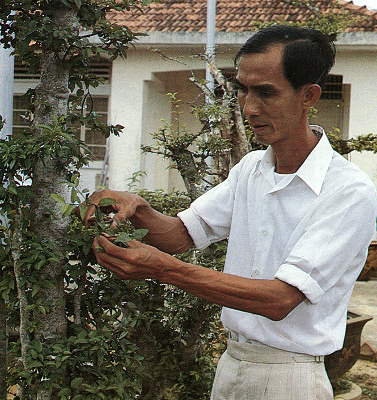
Boh Chit Hee
(Arts & Crafts Magazine, 19915, Unit 16) 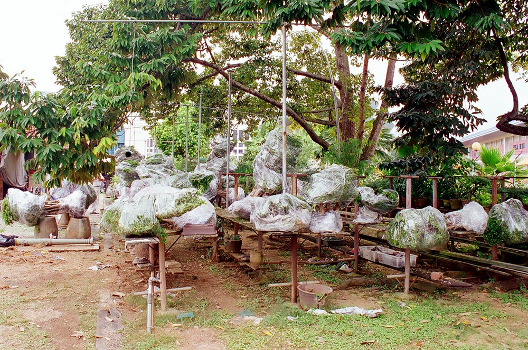
Boh Chit Hee's trees wrapped for the trip to the Shanghai Botanical Garden.
(E-mails to RJB from Mo Zhuang Ze on 2 and 6 Apr 2012; Chan, Gloria "Each of bonsai expert's dwarf plants has story
to tell," Straits Times, 5 Feb 1977; "Bonsai," MPH Living Magazine, June 1977, pp. 5, 27, 32;
"Singapore Bonsai Society, 5th Exhibition 1991" pamphlet, pp. 13-15, 17; Sim, Julie "Big trouble over little trees,"
Straits Times, 21 Oct 2002, pg. ; Chengtai Nursery's
Facebook
post of August 30, 2022.) SEE ALSO: Jan 23
(Photo courtesy of Mo Zhuang Ze to RJB, 6 Apr 2012) 1963 -- The Pennsylvania Bonsai Society was founded. [One of the oldest such clubs in the U.S., it would have active members from Pennsylvania, New Jersey, and Delaware. It would maintain a close working relationship with the Pennsylvania Horticultural Society and, because of this relationship, the Philadelphia area would have its first bonsai exhibit in 1964. The club would continue to have a presence at the well-known Philadelphia Flower Show. Early members of PBS would be instrumental in forming the national group, The American Bonsai Society (ABS), in 1967. PBS would host two ABS national symposia in Philadelphia, in 1969 and 1976.] ("Who We Are: PBS History, http://www.pabonsai.org/History.html) |
| 4 |
1904 -- Some 560 plants, all imported from Japan, were put on the auction
block over a three day period starting on this date. The sale was
sponsored by the S.M. Japanese Nursery Co. of West Orange, New Jersey and
took place in New York City. A 55-page catalogue was produced for the event
and included captioned illustrations for such trees as Item #340: "
Chabo-hiba
[Chamaecyparis obtusa, hinoki cypress]
. One of the most imposing-looking
specimens in this collection. This grand tree once belonged to the
famous temple Hongauji, Kyoto, the ancient Capitol of the Japanese Empire.
It has been said that owing to its most attractive shape, this specimen
was admired by almost a million people, who made the pilgrimage to this
noted temple of Buddha. It was trained by the several master gardeners
who gave their services to the temple. Trained in the standard Jikka
style. Note: its most graceful branches extended into both sides.
About 100 years old; height, 2 feet, 6 inches. With Chinese pottery
pot on stand." Of the plants auctioned, 135 were these compact hinoki cypress,
59 were maples [Acer species], 38 were Larix kaempferi, 28 were Japanese white pine
[Pinus parviflora], 20 were Chinese junipers [Juniperus chinensis],
9 were Podocarpus species, and 2 were sago palms [Cycas revoluta].
(Early American Bonsai: The Larz Anderson Collection of the Arnold Arboretum
by Peter Del Tredici; 1989, pp. 5, 19. Photo of #340 on latter page; the
catalogue's front cover is reproduced as the cover of this book; "From Temple to Terrace,
The Remarkable Journey of the Oldest Bonsai in America" by Peter Del Tredici (Jamaica, MA:
Arnold Arboretum, Harvard University: Arnoldia 64/2-3, 2006), pp. 13, 30. The catalogue's
front cover is in color on pg. 12) SEE ALSO: May 26, Nov 6, Nov 15
1987 -- Shimpaku collector Tetsuya Nakamura died in a fall on Mt. Myouji. (He had been leader of the Itoigawa Collectors' Union which was formed in 1979, and began to emphasize safety as a priority. This organization paid a fee for permission to enter the mountains to the Kotaki Production and Forest Union and its dozen or so members were allowed to enter between April 12 and June 15. Nakamura was a sensible and cautious man who took great care to see that collectors were not injured. He had retired once in 1983. Four years later, after praying at his household shrine as usual, he went to the mountain with his Eisen, a device with claws to put over boots to prevent slipping on ice.) There was still snow in the sunken areas of the rocks. He probably fell because he had changed to a new Eisen with which he was unaccustomed. Naturally dwarfed shimpaku junipers (Juniperus chinensis sargentii) were found growing in the mountains in Niigata Prefecture near the western coast of Honshu. Called Itoigawa Shimpaku in reference to the town there where they were bought and sold after being collected, these specimens have been highly prized by bonsai enthusiasts for a century. ("The Shimpaku Juniper: Its Secret History, Chapter VIII: Supply Diminished, Dangers Increased" and "Chapter IV: Famous Collector, Tahei Suzuki" by Kazuki Yamanaka, Kindai Bonsai Magazine, June 2003, translated by Ikuyo Shisaka for World Bonsai Friendship Federation, http://www.bonsai-wbff.org/shimpaku/shim8.shtml and http://www.bonsai-wbff.org/shimpaku/shim4.shtml ) SEE ALSO: Jun 4 |
| 5 |
1911 -- Frank Masao Okamura was born in Hiroshima. [He would move to California
as a 13-year-old to join his father, who had gone there in search of work. Frank would then
live with a British family while attending high school and go back to Japan briefly to marry.
He and his wife, Toshimi Nishikubo, would return to America to set up a small gardening business
in the Los Angeles area. The business would be lost in 1942 when he, his wife and their two
young daughters, Mihoko and Reiko, would be sent sent to the Manzanar Relocation Camp in the California desert.
The family would live there for three years and eight months, until the war ended. Eager to
leave California after their release, the family would move to New York, where Frank would first take jobs
waiting tables and setting pins in a bowling alley. He would finally be hired by the Brooklyn
Botanic Garden in 1947 to tend its Hill and Pond Japanese garden, which had been vandalized during the war and was in poor
shape. Frank would slowly nurse it back to health. He also would become involved with
the garden's small bonsai collection, which had been in existence for 20 years but had never been
fully appreciated by the staff until American soldiers began returning from Japan with souvenir trees.
Many of the veterans would come to the garden for advice on caring for their bonsai, and their questions
would often be directed to Frank. Eventually, the garden would arrange for him to begin teaching
classes. Though never formally trained in the art of bonsai, Frank would be knowledgeable and
skilled. He taught his many thousands of students that practicing bonsai required patience, sensitivity to nature
and five fundamental qualities: humanity, justice, courtesy, wisdom, and fidelity. Fearlessness might
be added to the list: he would be remembered virtually hanging off precipices in the
Catskills Mountains to get saplings he thought would make good bonsai trees. Frank created countless
examples of bonsai, both at his home and at the Brooklyn Botanic Garden, on whose staff he would be until 1981.
Under his care the BBG's collection of bonsai would grow in size and importance. He would lecture nationwide,
often exchanging his services with a local club for a tour of the neighboring areas. He would participate in such
conventions as BCI Cleveland, OH 1971; ABS Norfolk, VA 1971; ABS Kansas City, MO 1975; and the joint ABS-BCI New York
City 1979, where he would headline with John Naka and Yuji Yoshimura. He would write articles on the subject
for the World Book Encyclopedia and Kodansha's Encyclopedia of Japan, and do the ten drawings in the chapter
"Illustrated Guide to Styles" in the BBG's Bonsai For Indoors (1976). (He would even be a guest on the TV
program "What's My Line" in the mid-1960s.) Japanese Emperor Hirohito would award
Frank an Order of the Sacred Treasure medal in 1981 for his work in furthering knowledge of bonsai. Frank's
wife would die in 1987, and he would die nineteen years later, being survived by their two daughters, Reiko and Mihoko.]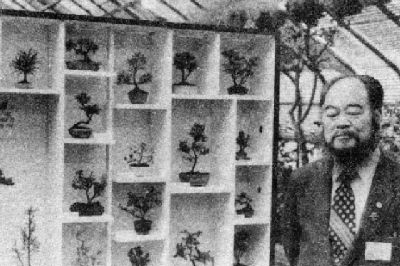
"Indoor Bonsai with Frank Okamura at the show
by the Brooklyn Botanic Garden, NY (photo by Phil Tacktill, NY)" (Bonsai Magazine, BCI, May 1976, pg. 114) 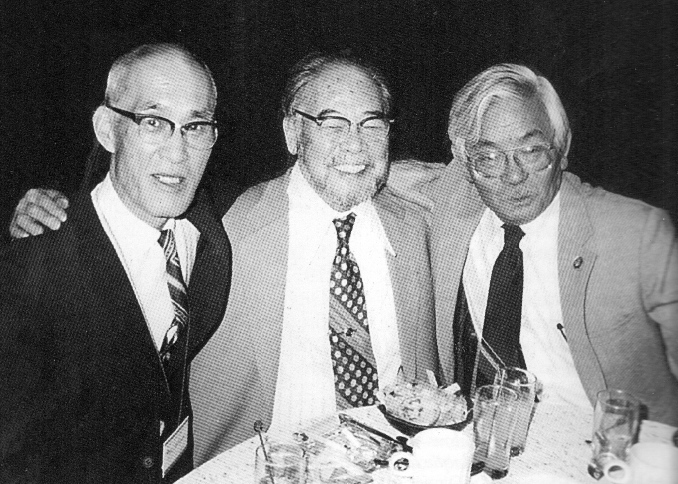
"Three bonsai masters enjoying the banquet at the Mid-Atlantic Bonsai Festival in April
(Obituary by Botanic Gardens Conservation International, Jan. 18, 2006,
http://www.bgci.org/worldwide/news/0157/;
Designing Dwarfs in the Desert by Robert J. Baran, pg. 32; Outstanding American Bonsai by Randy
Clark, pg. 34) SEE ALSO: Jan 16, Jan 26, May 26, May 29, Jul 10, Jul
16, Aug 3.
1983 in North Bergen, New Jersey. Left to right -- Yuji Yoshimura, Frank Okamura, Japanese gardener & bonsai curator at the Brooklyn Botanic Garden and John Y. Naka from Los Angeles, California" (International Bonsai, IBA, 1998, No. 1,pg. 38) 1921 -- Marion Gyllenswan was born. (She would become involved in bonsai, working behind-the-scenes in a few major groups.) ("MARION R GYLLENSWAN" in Persons born on 5 May 1921.) SEE ALSO: May 2 2007 -- This was the start of the two-day first bonsai convention in Kastela, Croatia with a small exhibit of trees from Croatia and Slovenia at the site of the Castle Vitturi. Hosted by the Dalmatian Bonsai Club, the event included Walter Pall holding demonstrations. (Hajdic, Marija "The first bonsai convention in Croatia," Bonsai Focus, 4/2007, July/August, pg. 9) SEE ALSO: Jul 20 |
| 6 |
1991 -- Grenada Grenadines (northern portion of Grenada) issued a set
of 8 postage stamps plus four souvenir sheets to commemorate Phila Nippon
'91. Walt Disney characters demonstrate Japanese arts, crafts and
industries. One of the souvenir stamps, which shows Mickey Mouse
as a tea ceremony master, has a small, low and wide
bonsai
as a decoration just below and to the left of the center of the souvenir sheet.
SEE ALSO: Jan 23, Jan 29, Feb 3, Feb 16, Mar 1, Mar 27, Mar 31, Apr 3, Apr 6, Apr 18, May 29, Jun
16, Jul 20, Aug 20, Aug 22, Sep 22, Oct 1, Oct 4, Dec 9.
2001 -- Hayward, California nurseryman and bonsai artist Toichi Domoto died at the age of 98. His greatest legacy would be the approximately two-century-old Acer buergerianum bonsai known as the Domoto Maple.] (personal emails to RJB from Ken Tsukada, Toichi Domoto's nephew, Oct 11 and 18, 2023) SEE ALSO: Feb 20, Oct 7, Nov 4, Nov 6, Dec 11 2011 -- Keith B. Scott died from pneumonia. (Born around 1926, he grew up in Salem, Ohio where his father worked in one of the potteries common to that area at the time. His father had also done missionary work in Japan and often described to him the miniature trees he had seen there. Keith became addicted to bonsai in 1938. (He would also later do pottery during winters, having learned how to from his father.) Keith's first contact with bonsai came while serving in the military in Japan during the Korean conflict. There he had the opportunity to see these trees first hand and to develop his lasting appreciation for Japanese aesthetics and traditions as well as providing a basic understanding of the language. Upon returning to the U.S., Keith attended Purdue University and obtained a Masters Degree in English Literature. He taught English and and was an adjunct professor of English at Youngstown State University in Ohio. He eventually settled on a teaching position in the Shaker Heights School system at a time when it was considered one of the 10 best public school systems in the country. In 1961 Keith joined the Cleveland Bonsai Club and began a serious pursuit of the art of bonsai. He would eventually start a nursery and import business in Chagrin Falls, OH in the 1960's and 70's that established him as one of the very first Americans to deal in bonsai stock, pots and tools. He traveled to Japan and to China fifteen or more times. Keith later wrote "...that is the point: I learned early that if I was going to succeed in this infinitely difficult hobby, I'd have to travel, seek out the people who knew more than I did, which was everyone." He studied with many bonsai masters in the U.S. and Japan, including Yuji Yoshimura, Frank Okamura, John Naka, Toshio Nakamura, Tom Yamamoto, and Toshio Saburumaru. He then moved to Pittsburg, PA and became the curator of the bonsai collection at the Phipps Conservatory and Botanical Gardens. He was the Bonsai Clubs International president ('71-'72), director ('76-'78 and '84-'86), and convention chairman. Keith shared an extensive treasure trove of bonsai knowledge and trivia with the skill of an accomplished wordsmith. He contributed numerous articles to the bonsai publications being established during this period. There were in BCI Bonsai Magazine some 21 "Tree of the Month" columns between 1969 and '73, and 37 other articles between 1966 and '84. The ABS Bonsai Journal saw three articles from 1968 to '86. And to International Bonsai Magazine he supplied 24 "Tricks the books never told us" pages from 1979 to 1985. The Columbus Bonsai Society Club logo tree came from his nursery. (Keith's first visit to that club included a hornbeam grove planting demo and a workshop in March of 1974.) Dawes Arboretum has a Scotts pine that also came from his nursery at the same time. A Smooth leaf Elm (Ulmus minor) that Keith trained and donated is on display at the North American Collection at the National Bonsai & Penjing Museum at the United States National Arboretum. He was a frequent teacher and lecturer at and strong supporter of Ohio and Pennsylvania clubs. He conducted many workshops for them, again, with his strong sense of humor. Keith was a long-time driving force in the bonsai world particularly in the northeast U.S., and an ABS and BCI symposium/convention speaker on many occasions -- between 1971 and 1994 he was at 5 ABS, 2 BCI, and 3 joint conventions. Plus the first four International Arboretum seminars. Keith's sleeping quarters were very nice and Japanese with tatami mats, wood flooring and a tokonoma. He slept on a futon and began to have terrible aching in the winter when it was very cold in his bedroom, which was attached to his work area in a barn away from the house. He did not live in the house. During the late 1980's he briefly slept on a waterbed which he kept unheated, but gave that up to return to a futon. For the last few years he had been living in the SE Ohio area. He was a serious and accomplished potter, a knife and tool maker, a wood worker, a gardener and always a lover of great literature. Keith was a uniquely talented and intellectually gifted man who touched the lives of many people and who leaves this world a much richer place.) 
Display Ad (Bonsai Magazine, BCI, Vol. X, No. 1, February 1971, pg. 11) 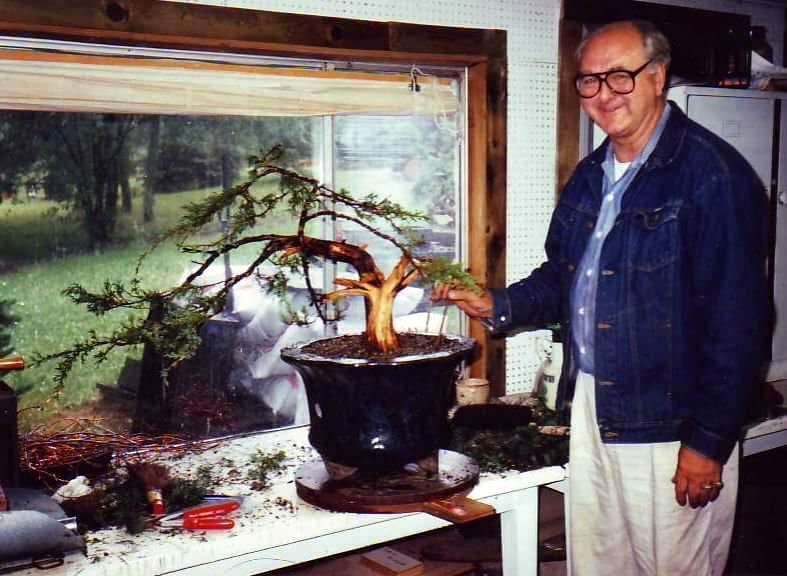
Keith Scott, c. 1985, working on an Andorra juniper given to him by Dale Cochoy, who had collected it. (Dale Cochoy to RJB, 01-06-18) 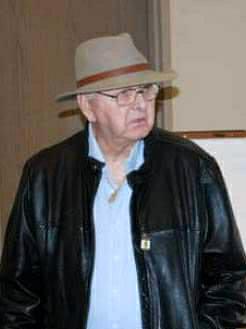
Keith Scott, October 25-26, 2008, while a guest at the Columbus Bonsai Society show (Dale Cochoy to RJB, Jan. 6 and 18, 2018) |
| 7 |
|
| 8 |
|
| 9 |
1949 -- Dale A. Cochoy was born in Akron,
Ohio. [He would attend Kenmore
High School and then study Vocational Trade and
Industry Education at Kent State University. He would begin studying bonsai in 1978, working
alone and getting nowhere. In 1979 he would start working at
GE
Medical Systems and found out that a fellow he worked with had been interested in bonsai for about
3 years. They would eventually start a part-time business together in 1985, Wild Things Bonsai
Nursery. The big jump would also come that year when Dale would begin studying with Ohio bonsaiman
Keith Scott for 3-1/2 years. Every Saturday and Sunday for a year and then every Sunday after
that (Dale's wife, Nancy L. Bodine Cochoy married in 1970, would be complaining) for 2 years. Studies would be about
twice a month during the last 6 months. His business partner and he would start selling collected
Ohio native plants and Brussels Bonsai Nursery imports later
on. Their first sales would be at the Cleveland Bonsai Club annual shows
starting about 1984. They would also start vending at Bill Valavanis's annual
Rochester symposiums in the late 80's.
Their first national convention gig would be
American Bonsai Society's at Columbus, OH at the
student union at the college in late June 1990. The headliner would be John Naka. Keith Scott, Kelly
Adkins, Jerry Meislik, Marion Gyllenswan, Marian Borchers, Jerry Stowell and José Cueto would also be
demonstrating there. Dale's business partner and he would supply workshop trees for Jerry and
demo trees for Jerry (a multiple trunk, root-connected-style Alberta spruce) and Marion (a collected
Andorra juniper). Bill Valavanis would help Marion with hers. [Dale would go full-time with the business in 1995, "Wild Things Bonsai Studio," becoming a full-service dealer of domestic and imported bonsai, pottery, tools, and other bonsai accessories including oriental art objects. The first pots he would make would be in the mid-1980's. His old business partner and he would mold some Japanese and plastic pots, cast them and have them fired locally. Dale would make trays and land & water pots from trays then also. Once they would have an actual business, though, they would stop pot-crafting after an accident of a mold breaking open in his buddy's kitchen and a plaster of paris mess ensuing. Dale would be producing his own hand-built, one-of-a-kind stoneware "Wild Things" bonsai pottery since 1998, initially making slab-built pots for sale. He would buy a used electric kiln, and then a wheel. The gas kiln would come a few years later. In 2001, he would win 2nd place (Modern Category) in the National Bonsai Foundation's First North American Bonsai Pot Competition which would have been held in conjunction with the Asian Arts Festival celebrating the 25th anniversary of the bonsai collection at the National Arboretum in Washington, D.C. He would be one of the nine members of the jury for the Second Competition the following year, along with Jim Barrett who won 1st place and Mike Hansen who won 3rd place. In the latter part of 2002 Dale would rename the pottery portion of his business to "Yakimono no Kokoro" (Heart of Fired Things), as he would feel a more fitting name was needed to express that part of the business. He would have a bonsai container in the "From The Hands Of" bonsai pottery display in the 2005 World Bonsai Convention in Washington D.C., and one of Dale's trees would also be chosen for the display there. The tree would be a collected American Larch which was potted in a bonsai container that Dale made specifically for the tree. Dale would twice enter photographs of a personal tree in the World Bonsai Photo Contest and each time the tree would be selected in the top 100 entries. Dale would also specialize in the sales of many varieties of power wood carving tools for use in bonsai styling, and he would be the USA importer/distributor for the "Samurai" line of bonsai power wood carving tools. [Dale would be a founder of the Akron/Canton Bonsai Society in 1994 and serve as President and Vice President. He would also be a past President and Vice President of the Cleveland Bonsai Club. He would be a member of the Board of Directors of the American Bonsai Society from 2000-2004. He would contribute at least nine articles to the ABS Journal between 1990 and 2003. Dale would maintain his bonsai business and garden in Hartville, Ohio. He would also travel throughout the United States to vend at conventions and teach bonsai and pottery workshops and demonstrations. He would be a vendor at many national conventions and symposiums over the years and would be the only American vendor at the 3rd World Bonsai Convention in Seoul, Korea in October 1997. For the BCI Bonsai Magazine in 1999 he would write a two-part article on vending in Korea from a vendor's point of view. Dale would be attending the July 1997 Bonsai Clubs International convention in Toronto, Canada as a vendor when he would meet Mr. Chul-ho Lee, the Chairman of the Organizing Committee for the upcoming 3rd World Bonsai Friendship Federation convention to be sponsored by the Korean Bonsai Association in late October. Mr. Lee would be very interested in the tungsten carbide steel grinding burrs and handmade jin and shari carving tools and blades that Dale would have for sale. Mr. Lee would speak to him twice during the convention with the aid of his interpreter about the unavailability of these items in Korea and would very cordially invite him to be a vendor at the convention. Dale would be very honored to be the only non-Korean vendor to be invited to the convention by Mr. Lee. Dale would speak with the carving burr manufacturer and obtain an excellent one-time deal for product purchase after he would convince them that this would be the perfect opportunity to help open up future business in Korea which was not an export customer yet. So Dale would travel to Asia with three suitcases full of product weighting close to 170 pounds (77 kg) total, and would be able to set up shop with a small table and signage at the convention aided by a very helpful interpreter. (In April 1998 Mr. Lee would die suddenly from a heart attack.) Dale would also be a vendor at the 5th World Bonsai Convention in Washington D.C. in May 2005 and at the 6th World Bonsai Convention in San Juan, Puerto Rico in July 2009. [An August 2011 Carving Tool Demo before the Midwest Bonsai Society can be seen here, Part I and Part II. By November 2011 he would have set up a Facebook page, https://www.facebook.com/WildThingsBonsaiStudio/ where he would eventually post over a thousand photos of his pots. A the end of May 2012, Dale would fall about 20 ft. off a ladder while trimming a branch off one of the large trees in the garden. He would suffer 4 fractured vertebra in his low back, 5 broken ribs and internal bleeding. He would be in intensive care at Akron General Medical Center. (The following day, Nancy would get a call at the nurses' station that their youngest son, Cody, was in an accident and in intensive care at the hospital across town. Rushing over, she would be told that he had a fractured skull, multiple facial fractures and a broken jaw, going through the windshield of Dales' van which was rolled and was full of all the pots he made all winter.) Before the end of June both father and son were home and recovering slowly. In September 2012, after almost three years of trying to sell his trees to individuals, Dale would have about 110 trees, almost all of his entire bonsai collection, bought by Kurtis Smith of The Flower Market in Monroe, Michigan. Most of Dale's viewing stones/suiseki and Japanese/Chinese pottery stock would also be sold. He would then continue producing his hand-made bonsai pottery and selling the power wood-carving tools for bonsai. Down from an all-time high count of 425 trees years earlier, Dale would keep a collection of 15 to 30 small to medium-sized loved and appreciated trees with some meaning or that he just wanted to finish. Dale and Nancy's yard would now be able to be landscaped. Dale would also be a long-time motorcycle enthusiast. In early July 2018, after two months of hospitalizations and tests for various problems, Dale would sell the rest of his trees and his hand-made custom pots to Joseph Freeman. Two rounds of chemotherapy would be undergone for metastatic pancreatic cancer that was worsened by blood clots in each lung. The treatment was then moved away from. Final pot firings would take place in November -- one of the last pots happening to be made (ordered a year earlier) on commission for Eric Zimmett of the Phoenix Bonsai Society. The very last pot was an elongated pentagon/foreshortened casket-shaped vessel whose underside bore the legend "SAYONARA!" The kiln, wheel, and accessories would be passed on to another potter at the beginning of December.] 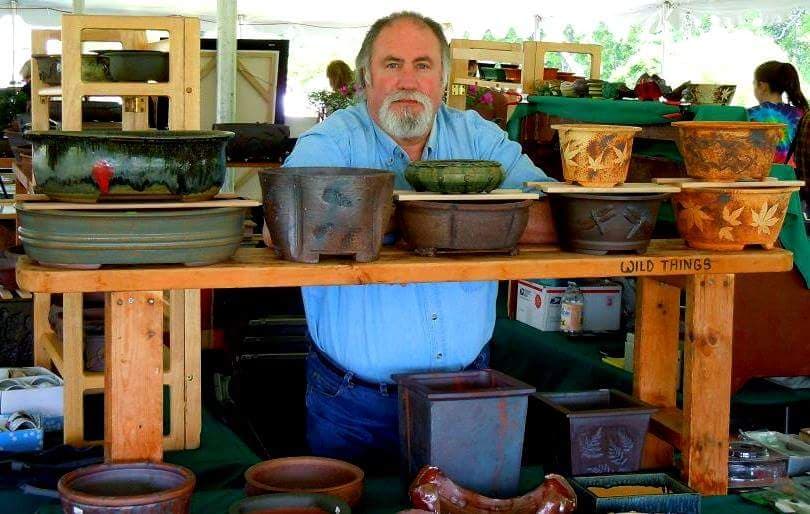
Dale Cochoy, potter and vendor.
(Facebook posting Nov 30, 2013 in answer to Jim Osborne's question "When do you first get into
bonsai?"; Facebook posts July 13, 2017 and July 7, 2018; private Facebook Messenging with RJB Dec. 27 and 30,
2017 and Jan 7, 2018; "Dale Cochoy @ Wild Things Bonsai Studio selling off bonsai collection," Internet Bonsai
Club postings, Sep. 29-30, 2012,
http://ibonsaiclub.forumotion.com/t11576-dale-cochoy-wild-things-bonsai-studio-selling-off-bonsai-collection;
The National Bonsai Foundation, Winter 2001 Volume XII, Number 2, pg.
5; "Dale
Cochoy hurt in fall," Internet Bonsai Club postings, May 31, 2012,
http://ibonsaiclub.forumotion.com/t10347-dale-cochoy-hurt-in-fall;
per a note on Facebook on 26 Mar 2019 by Mitch Alan Boatman to RJB's posting of this bio, "the last pot he ever
made was NOT for Eric Zimmet. It was his trademarked 5 sided pot that Kennett bonsai bought that was the
very last one to be made by Dale. That is even written in that pot saying so." Late on 31 Mar, Mitch
posted 3 views of the vessel with the caption "Dale's very last pot he ever made further confirmed by his wife
and son"; Facebook Messenger photos of Bonsai Nut posting from Jul 7, 2018 sent by Mel Carrillo to RJB Jan 4, 2020.)
SEE ALSO: Jan Also, May 2, May 6, Jun 9, Sep 3, Dec 31
1987 -- The Bonsai Pavilion opened in the Kupanda Falls Botanical Center section of the 1,800-acre San Diego Wild Animal Park. This coincided with the Park's 15th Anniversary. Master John Y. Naka cut the ribbon and the first and largest display facility for bonsai in the Western United States was opened to a crowd of more than 200 bonsai lovers. (The first tree donated at the beginning of the Pavilion development was the "Wild Dragon" California Juniper by John and Alice Naka. John later made suggestions and recommendations about the Pavilion which was constructed over a period of two years through the joint efforts of the Wild Animal Park, the San Diego Bonsai Club, and the San Pu Kai Club.) [For the 10-year anniversary John and Alice would visit the Park and rededicate the tree. This would be on the special "John Naka Day" celebration for which the master was presented with a certificate and a medal. Most of the trees would be donated. By 2004 there would be approximately sixty trees in the collection, fifty on display. The rest would be in a growing area and rotated with the seasons. Some ninety volunteers from the two clubs would work and care for the trees. Viewing stones (suiseki) would be donated by Harry Hirao.] ("The Bonsai Pavilion at the Wild Animal Park, San Diego County, California," www.sandiegobonsaiclub.com/web/events/sdwapbp/NABFarticle.pdf) SEE ALSO: Apr 9, May 14, Oct Also, Dec 28 |
| 10 |
|